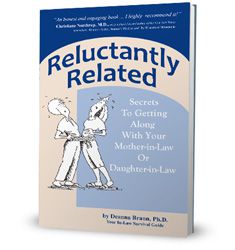Reluctantly Related: Secrets To Getting Along With Your Mother-in-Law or Daughter-in-Law
 Dr. Brann, a licensed clinical psychotherapist, begins this book by telling of her own experience with her daughter-in-law, sharing an example of a family thanksgiving get-together that became a disaster because both she and her daughter-in-law interpreted events from their own perspectives.
Dr. Brann, a licensed clinical psychotherapist, begins this book by telling of her own experience with her daughter-in-law, sharing an example of a family thanksgiving get-together that became a disaster because both she and her daughter-in-law interpreted events from their own perspectives.
To make the situation totally clear, she tells us both sides of the story. This provides her with a good relatable lead-in to the challenges of the mother-in-law (MIL) daughter-in-law (DIL) relationship, including:
- the artificiality of the relationship
- the different stages of life (generally different generations)
- the personal history and emotional baggage we all carry
At the heart of this book are Dr. Brann’s analysis of the characters involved in our relationships. She begins with the important clarification that there are actually not two but four people who are always involved in the dynamics of any MIL-DIL relationship.
Yes, four: In addition to the MIL and DIL, the husband/son and the DIL’s mother are also involved. In fact, she says, the DIL’s relationship with her own mother has a huge impact on the MIL-DIL relationship – even if the DIL’s mother is no longer living.
I found this totally relatable, as I once heard someone like Dr. Phil opine that whenever a couple is in bed together, there are actually not two people there, but four. (I don’t recall exactly who the other two are, but it was the same concept. They “phantom” bed partners are people from our pasts.)
I enjoyed how Dr. Brann names the personality types for each group:
She first identifies four different personality types of MIL:
- Comfortable Carla
- Mothering Margaret
- Off-the-Wall Wanda, and
- Uncertain Sara
To be fair, she also sees four different personality types of DIL:
- Confident Connie
- Doubting Donna
- Weird Wendy, and
- Transitioned Tracy
And, not to leave the men out of the equation, she also recognizes and three different personality types for the husband/son:
- Self-Assured Andy
- In-the-Middle Michael, and
- Struggling Steven
Since I’m a big believer in the Myers-Briggs personality style analysis, and have used in in my business, I found this very natural. And an easy way to focus on the particular needs of each character. And just as how the Myers-Briggs assessments help differing personality styles get along together in a business setting, these profiles exemplify how a MIL or a DIL can begin to understand where the DIL or the MIL is coming from.
And knowing this is crucial to making in-law relationships work effectively. It’s sort of a “walk a mile in my shoes” kind of thing, if you will. Briggs points out that learning to manage our expectations is important, just as is recognizing boundaries and holding mutual respect. She also shows how humor can be an effective way to defuse or uncomfortable hot situations.
Brann includes questionnaires so readers can readily identify personality types, patterns of behavior and know how to deal with them.
Beyond being a MIL herself, Deanna Brann, Ph.D., clearly has the credentials to write this book. She is a leading expert in the field of mother-in-law/daughter-in-law relationships with over 25 years’ experience as a clinical psychotherapist, in addition to running her own private practice for more than 18 years. You’ll want to check out her website to sign up for her free newsletter, too.
I can’t close this review without mentioning that the book features wonderful illustrations by Donald Hoenig. I found them helpful in lightening up what might otherwise be a really heavy subject.
Finally, I’ve been blessed with wonderful mother-in-law, but I know many people, including my own mother, who suffer greatly as a result of these relationships. Which is why, IMHO, this wonderful little book ought to be a required shower gift for every new bride – and her mother-in-law!



Leave a Reply
You must be logged in to post a comment.